|
The
Ultimate All-in-One
by
Bob Brooke
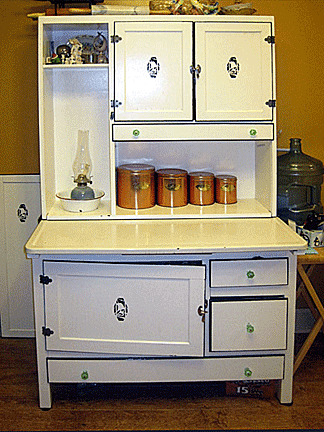 According
to an advertising pamphlet put out by the Hoosier Manufacturing Co.,
housewives could save a lot of time if they did all of their kitchen
work around the Hoosier cabinet. After several studies, domestic science
experts discovered that the time spent in making a cake at a Hoosier was
40 percent less than it took to make one without a Hoosier. According
to an advertising pamphlet put out by the Hoosier Manufacturing Co.,
housewives could save a lot of time if they did all of their kitchen
work around the Hoosier cabinet. After several studies, domestic science
experts discovered that the time spent in making a cake at a Hoosier was
40 percent less than it took to make one without a Hoosier.
One study showed that before using a Hoosier cabinet, it took a
housewife nine minutes to collect all the utensils needed to make a
cake, then nine minutes to mix it and eleven minutes to clean up. With
the Hoosier that same cake took two minutes to collect the materials
needed, nine minutes to mix, and just four minutes to clean up.
Of course, these studies took place in the 1920s when the Hoosier
Manufacturing Company of New Castle, Indiana., was at the height of
production and long before microwaves and instant meals made their way
into the kitchen. Today, if a woman wants to make a cake, she opens a
box of cake mix, adds water and an egg, stirs the ingredients for a
couple of minutes, and pops it into the oven to bake. For some, even
that’s too long, so they just purchase a cake at the supermarket.
The term “Hoosier” has come to mean any free-standing kitchen cabinet
with work surface and space for things like a flour sifter or spice
jars. Since many of the other makers of similar cabinets called Indiana
home, they named the cabinet after their state’s nickname, the Hoosier
State. The large number of Hoosiers produced—approximately 700 a
day—also helped to endear the name to future generations.
How It All Began
The Hoosier Manufacturing Company, founded in 1898, first produced these
all-in-one cabinets. Back then, kitchens didn’t have built-in cabinets,
and the lack of storage space in them became a problem. Hoosier adapted
an existing furniture piece, the baker's cabinet, which had a similar
structure of a table top with some cabinets above it—and often flour
bins beneath. By rearranging the parts and taking advantage of modern
metal working techniques, the company was able to design a
well-organized, compact cabinet which answered the homemaker’s needs for
storage and working space.
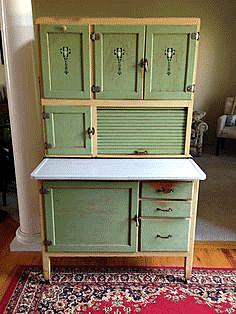 The
firm actually started in Albany, Indiana, in 1899, but a fire soon
forced owner J.S. McQuinn to look for a new home. He picked New Castle,
where he took over a large building that had been a bicycle plant.
McQuinn’s company was the first furniture maker to advertise in national
magazines and the first firm to institute a "dollar-down, dollar a week"
policy to purchase their cabinets. The
firm actually started in Albany, Indiana, in 1899, but a fire soon
forced owner J.S. McQuinn to look for a new home. He picked New Castle,
where he took over a large building that had been a bicycle plant.
McQuinn’s company was the first furniture maker to advertise in national
magazines and the first firm to institute a "dollar-down, dollar a week"
policy to purchase their cabinets.
The firm aimed its advertising at homemakers to show them how much time
the Hoosier would save them. The ads also hinted to men that a woman who
was happier in the kitchen would be happier over-all.
A revolution in the kitchen, the Hoosier cabinet could easily be
compared to the invention of the microwave. Prior to its invention, a
housewife would have kept her supplies in a pantry as well as on hanging
shelves. She may have had to climb a ladder to reach the top shelves in
the pantry. McQuinn designed the Hoosier so that everything a woman
needed in the kitchen could be kept in the cabinet. Then she only had to
travel from the icebox to the cabinet during food preparation. Most of
the company literature used the word "scientific" and explained how it
had used scientific principles to save time and steps. For instance, it
grouped flour, sugar, spices, tea and coffee, plus all spoons and little
articles and packaged foods used several times in preparing a meal
together around the table space, so that a woman could reach article
needed without bending or taking a step.
Features of the Hoosier
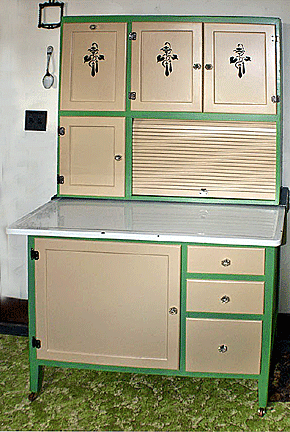 Hoosier
cabinets evolved from baker’s cabinets popular during the 1800s.These
baker’s cabinets were simple, often homemade devices, with a set of
shelves for storage, a work surface, and drawers. They often included
“possum belly” drawers made of tin to hold flour and sugar so that mice
couldn’t get at them. The company first made the countertop of wood,
then later zinc, aluminum, and finally porcelain. The legs ended in
casters, both for ease of moving the cabinet and to keep the ants out of
it. Hoosier
cabinets evolved from baker’s cabinets popular during the 1800s.These
baker’s cabinets were simple, often homemade devices, with a set of
shelves for storage, a work surface, and drawers. They often included
“possum belly” drawers made of tin to hold flour and sugar so that mice
couldn’t get at them. The company first made the countertop of wood,
then later zinc, aluminum, and finally porcelain. The legs ended in
casters, both for ease of moving the cabinet and to keep the ants out of
it.
The typical Hoosier cabinet consisted of three parts. The base section
usually had one large compartment with a slide-out shelf, and several
drawers to one side. The top portion was shallower and had several
smaller compartments with doors, with one of the larger lower
compartments having a roll-top or tambour. Designers cleverly joined the
top and the bottom of the cabinet using a pair of metal channels which
served as the guide for the sliding countertop, which usually had a pair
of shallow drawers affixed to its underside. The whole assembly, with
the counter retracted, was only about two feet deep, while the cabinet,
itself, was about four feet wide and six feet tall.
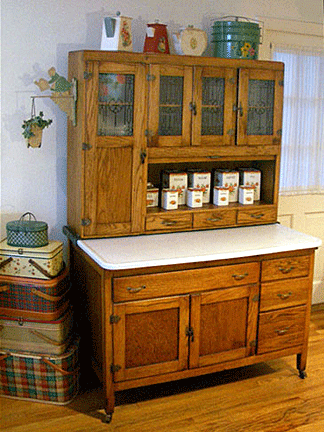 As
originally supplied, Hoosier cabinets came equipped with various racks
and other hardware to hold and organize spices and various staples. The
Sneath Glass Company manufactured special glass jars to fit the cabinet
and its racks. Original sets of Hoosier glassware consisted of coffee
and tea canisters, a salt box, and four to eight spice jars. Some
manufacturers also included a cracker jar. One distinctive form was a
cylindrical jar with a ring molded around its center to allow it to rest
in the holes of a metal hanging rack. On the inside of the doors, it was
common to have cards with such information as measurement conversions,
sample menus, and other household helps. As
originally supplied, Hoosier cabinets came equipped with various racks
and other hardware to hold and organize spices and various staples. The
Sneath Glass Company manufactured special glass jars to fit the cabinet
and its racks. Original sets of Hoosier glassware consisted of coffee
and tea canisters, a salt box, and four to eight spice jars. Some
manufacturers also included a cracker jar. One distinctive form was a
cylindrical jar with a ring molded around its center to allow it to rest
in the holes of a metal hanging rack. On the inside of the doors, it was
common to have cards with such information as measurement conversions,
sample menus, and other household helps.
Hoosier built over four million cabinets between 1900 and 1940. For the
first 20 years, the company constructed and finished them in natural
oak. But in the 1920s, Hoosier started offering cabinets covered with
enamel. Because of the bright white of the enamel, the company dubbed
them with the name “White Beauty.“
Made for Women
Hoosier also went to great
lengths to show they had a woman's best interests at heart. They made
their cabinets adjustable because they realized not all women were the
same height. And because Hoosiers came with casters, they could easily
be rolled back from the wail for cleaning.
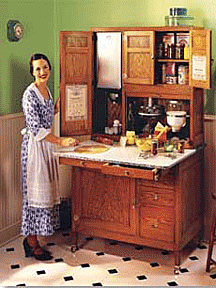 The
ads for the company also promoted the cabinet as helping to save a
woman's health. "Mark how she sits while working, thus escaping the
tired feeling that comes from being always on her feet," said a 1913 ad.
"Your work is hard enough at best and you owe it to yourself and your
family to secure this saving of your health and strength." The
ads for the company also promoted the cabinet as helping to save a
woman's health. "Mark how she sits while working, thus escaping the
tired feeling that comes from being always on her feet," said a 1913 ad.
"Your work is hard enough at best and you owe it to yourself and your
family to secure this saving of your health and strength."
And if all of this wasn't enough to convince a housewife to buy the
cabinet, a 1921 Good Housekeeping ad showed a woman, who was said to be
an efficiency expert, armed with a stopwatch and a pedometer. She proved
that a the average woman took 2,113 steps per day in the kitchen, of
which 1,592 could be saved if she used a Hoosier cabinet.
Although Hoosier cabinets remained popular into the 1920s, by that time
architects of new houses began to include built-in cabinets in their
kitchens, and the days of the Hoosier cabinet became numbered.
<
Back to Antiques Archives
Next Article >
|
